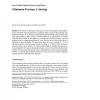Free Online Productivity Tools
i2Speak
i2Symbol
i2OCR
iTex2Img
iWeb2Print
iWeb2Shot
i2Type
iPdf2Split
iPdf2Merge
i2Bopomofo
i2Arabic
i2Style
i2Image
i2PDF
iLatex2Rtf
Sci2ools
85
Voted
ISAAC
2005
Springer
2005
Springer
Minimum Entropy Coloring
Abstract We study an information-theoretic variant of the graph coloring problem in which the objective function to minimize is the entropy of the coloring. The minimum entropy of a coloring is called the chromatic entropy and was shown by Alon and Orlitsky (1996) to play a fundamental role in the problem of coding with side information. In this paper, we consider the minimum entropy coloring problem from a computational point of view. We first prove that this problem is NP-hard on interval graphs. We then show that, for every constant ε > 0, it is NP-hard to find a coloring whose entropy is within (1− ε)logn of the chromatic entropy, where n is the number of vertices of the graph. A simple polynomial case is also identified. It is known that graph entropy is a lower bound for the chromatic entropy. We prove that this bound can be arbitrarily bad, even for chordal graphs. Finally, we consider the minimum number of colors required to achieve minimum entropy and prove a Brooks-...
Related Content
| Added | 27 Jun 2010 |
| Updated | 27 Jun 2010 |
| Type | Conference |
| Year | 2005 |
| Where | ISAAC |
| Authors | Jean Cardinal, Samuel Fiorini, Gwenaël Joret |
Comments (0)

